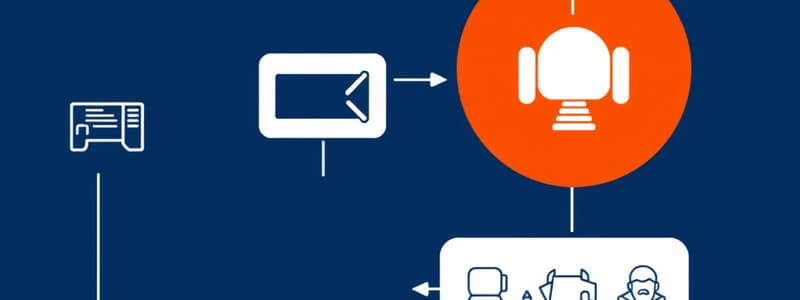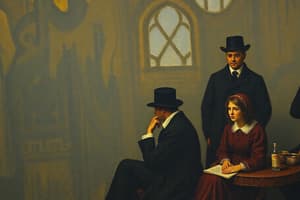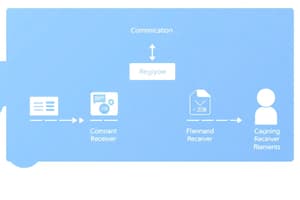Podcast
Questions and Answers
What is communication?
What is communication?
Any process in which people generate meanings within and across various contexts, cultures, channels, and media.
Which of the following are elements of communication? (Select all that apply)
Which of the following are elements of communication? (Select all that apply)
- Noise (correct)
- Feedback (correct)
- Setting (correct)
- Message (correct)
- Sender-receivers (correct)
- Channel (correct)
What do sender-receivers do?
What do sender-receivers do?
Both send and receive messages at the same time.
What is a message?
What is a message?
What is a symbol?
What is a symbol?
What are verbal symbols?
What are verbal symbols?
What are nonverbal symbols?
What are nonverbal symbols?
What is a channel in communication?
What is a channel in communication?
What is feedback?
What is feedback?
What is noise in the context of communication?
What is noise in the context of communication?
What is setting?
What is setting?
What is synchronous communication?
What is synchronous communication?
What is asynchronous communication?
What is asynchronous communication?
What are the three principles of transactional communication?
What are the three principles of transactional communication?
What are roles in communication?
What are roles in communication?
Which of the following are types of communication? (Select all that apply)
Which of the following are types of communication? (Select all that apply)
What is intrapersonal communication?
What is intrapersonal communication?
What is interpersonal communication?
What is interpersonal communication?
What is small-group communication?
What is small-group communication?
Flashcards are hidden until you start studying
Study Notes
Communication Process Overview
- Communication involves generating meanings using verbal and nonverbal symbols across contexts, cultures, and media; it is a dynamic process.
Elements of Communication
- Sender-Receivers: Engage in sending and receiving messages simultaneously, sharing meaning continuously.
- Message: Composed of ideas and feelings shared; relies on common referents for understanding and incorporates symbols.
- Channel: The medium through which a message travels, primarily sound and sight in face-to-face interactions.
- Feedback: Responses between sender-receivers; important for understanding and improving communication effectiveness.
- Noise: Interference in communication, classified as:
- External noise: Environmental factors hindering message clarity.
- Internal noise: Distractions from sender-receivers' thoughts or feelings.
- Semantic noise: Misunderstandings due to emotional responses to words.
- Setting: The communicative environment which changes how communication is perceived, including social power dynamics.
Symbols in Communication
- Symbol: Represents another concept; includes verbal and nonverbal forms.
- Verbal Symbols: Language words representing ideas; can be concrete (object-representing) or abstract (idea-representing).
- Nonverbal Symbols: Include facial expressions, gestures, and posture, with variations across cultures; often involuntary.
Internet Communication Dynamics
- Computer's Role: Acts as "the great leveler," altering social cues in communication.
- Synchronous Communication: Real-time interaction without delay (e.g., instant messaging).
- Asynchronous Communication: Interaction that does not happen simultaneously (e.g., email).
Principles of Transactional Communication
- Participation is ongoing and simultaneous; individuals are involved in both sending and receiving.
- All communication occurs within a context that encompasses past, present, and future influences.
- Communicators assume various roles, shaped by societal expectations and personal relationships.
Types of Communication
- Intrapersonal Communication: Internal dialogue and symbolic processing you conduct individually; examples include daydreaming, reading aloud.
- Interpersonal Communication: One-on-one interactions, typically informal, providing significant feedback opportunities.
- Small-Group Communication: Involves problem-solving among a few individuals; typically structured and formal.
- Computer-Mediated Communication (CMC): Uses various technologies for interaction, differing significantly from traditional face-to-face communication.
- Public Communication: Involves larger audiences, focusing on delivering messages to a wider public.
- Intercultural Communication: Addresses interactions across diverse cultural backgrounds, highlighting differences in communication styles and interpretations.
Importance of Feedback and Environment
- Effective feedback enhances mutual understanding and communication efficacy.
- The environment, including physical setting and arrangement, can profoundly affect interaction patterns and perceptions.
Studying That Suits You
Use AI to generate personalized quizzes and flashcards to suit your learning preferences.




